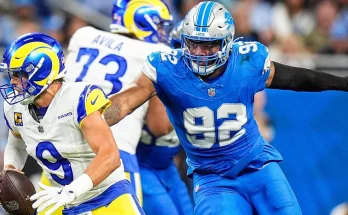The Minnesota Vikings’ offseason took another unexpected twist this week when general manager Kwesi Adofo-Mensah and head coach Kevin O’Connell addressed the possibility of veteran quarterback Aaron Rodgers wearing purple in 2025. While the organization didn’t close the door entirely on the idea of signing the former Green Bay Packers legend, they made it clear that if Rodgers were to land in Minnesota, he wouldn’t be handed the starting job outright.
It’s a nuanced stance that reflects both the delicate nature of Rodgers’ current status—aging, recovering from a devastating Achilles tear, and still holding elite pedigree—and the direction of a Vikings franchise that appears to be entering a transitional phase under center. With Kirk Cousins now a member of the Atlanta Falcons and rookie J.J. McCarthy drafted as the presumptive quarterback of the future, Minnesota finds itself at a rare crossroads, balancing short-term competitiveness with long-term planning.
Rodgers, who turned 41 in December and is currently under contract with the New York Jets, has not definitively declared his playing intentions beyond 2024. He missed almost all of last season after tearing his Achilles on the Jets’ opening drive in Week 1. His comeback has been closely followed, not just for its implications in New York but for the broader ripple effects across the NFL’s quarterback landscape. Rodgers has hinted that he does not want to end his career on an injury note, and many believe he still desires another deep playoff run before retiring.
What makes Minnesota an intriguing potential landing spot is more than just proximity and history. Rodgers spent 18 seasons with the Packers, often tormenting the Vikings twice a year with signature performances and clutch moments. Brett Favre’s post-Green Bay detour to Minnesota still lingers in the memory of fans and media alike—particularly the electric 2009 season that saw Favre lead the Vikings to the NFC Championship Game. Given that precedent, the notion of Rodgers following in Favre’s footsteps isn’t entirely far-fetched, though Vikings leadership insists this situation would be evaluated differently.
Speaking at a pre-draft press conference, Adofo-Mensah offered carefully worded remarks on the Rodgers speculation, neither confirming interest nor dismissing it outright. “We have respect for everything Aaron’s done in this league. Obviously, he’s one of the greatest quarterbacks of all time. Any time a player of that caliber might become available, it’s something you at least talk about internally,” Adofo-Mensah said. “That said, we’re focused on building a long-term foundation. We have quarterbacks on this roster we believe in, and that’s where our energy is going right now.”
O’Connell echoed a similar sentiment when asked directly whether Rodgers would be guaranteed a starting role if he were to sign in Minnesota. “I think anytime you bring a guy into the building, especially someone with a resume like Aaron’s, you’re going to evaluate him as a competitor. But nothing is ever handed out here,” the head coach said. “We believe in creating a culture of competition. That would apply to every position—including quarterback.”
The backdrop to this conversation is the Vikings’ quarterback room, which currently includes McCarthy, veteran Sam Darnold, and developmental prospect Nick Mullens. Darnold, signed to a one-year deal during free agency, brings starting experience and is expected to serve as a bridge if McCarthy isn’t ready to take the reins Week 1. But the long-term plan revolves around the rookie. McCarthy’s draft stock soared following his national championship run with Michigan, and the Vikings traded up to secure him as the 10th overall pick, an aggressive move that signaled intent.
Injecting Rodgers into that mix would bring enormous attention and complexity. On one hand, his presence could accelerate McCarthy’s development, much as Rodgers himself benefited from watching Brett Favre for three years before taking over in Green Bay. On the other hand, it could create a media circus, especially if Rodgers expects to start or if the team begins to struggle early and fans clamor for the future Hall of Famer to take the field.
The question, then, is not just whether Rodgers is interested in Minnesota—but whether Minnesota is willing to take on the baggage that comes with him. It’s a unique case study in team-building, especially for a franchise that seems determined to stay competitive in the NFC North while transitioning to a younger core.
Sources close to the Vikings front office suggest that the team is intrigued by the idea of adding a veteran mentor, but would only do so on their terms. Rodgers, despite his resume, would need to prove himself physically and mentally ready after a year away from the game. Minnesota’s decision-makers also remain wary of potentially stunting McCarthy’s growth with too many voices or a crowded depth chart.
That caution is not unfounded. Around the league, recent examples abound of young quarterbacks being thrown off course by veteran additions. In New England, Mac Jones struggled to establish consistency with multiple offensive coordinators and shifting quarterback rooms. In Chicago, Justin Fields’ development was questioned until the Bears ultimately chose to reset with Caleb Williams. The Vikings want to avoid such pitfalls with McCarthy, whose upside they are clearly betting on.
As for Rodgers, his relationship with the Jets has remained outwardly positive, but there have been subtle signs of friction. Reports indicate that Rodgers, while committed to returning in 2024, was disappointed by the lack of offensive line upgrades and remains uncertain about the Jets’ long-term direction. With Zach Wilson now out of the picture and the Jets’ playoff hopes resting largely on Rodgers’ health, the pressure is immense.
If things go south in New York, a parting of ways could become mutual. That’s where Minnesota—or another quarterback-needy team—could come into play. But Rodgers will need to assess what he wants out of his final seasons. Is he chasing a title at all costs? Or is he looking for a stable situation where he can control his narrative and legacy?
The Vikings, meanwhile, are taking a pragmatic approach. The franchise has been in “competitive rebuild” mode since Adofo-Mensah took over in 2022, threading the needle between contending and preparing for the future. Rodgers doesn’t quite fit that mold—but he could bridge the two timelines if the fit is right. And though O’Connell has worked with veteran quarterbacks in the past, including Cousins and Matthew Stafford, managing Rodgers would be a different challenge altogether.
Fan reaction has been mixed, with some Vikings faithful excited by the prospect of poaching a longtime rival and adding immediate credibility to the quarterback room. Others remain skeptical, pointing to Rodgers’ age, injury history, and polarizing presence. After years of Rodgers tormenting Minnesota defenses, the idea of cheering for him feels strange to many. Yet as was the case with Favre, time and winning have a way of reshaping narratives.
For now, all signs point to Rodgers remaining with the Jets for the 2024 season. But if things change—and they often do quickly in the NFL—the Vikings are not slamming the door. They’re simply leaving it ajar, with a firm grip on the handle.
It’s a position that allows for flexibility, one that keeps options open without committing too soon. And it underscores a core theme of the Adofo-Mensah era: calculated risk-taking, driven by data, relationships, and a long-term vision. If Rodgers becomes part of that vision, it won’t be because of nostalgia or desperation. It’ll be because Minnesota believes he can help them win—without derailing their future.
Whether Rodgers is interested in such an arrangement remains to be seen. He’s made clear throughout his career that he values autonomy, input, and respect. If the Vikings can offer those things without compromising their own trajectory, the door remains open.



